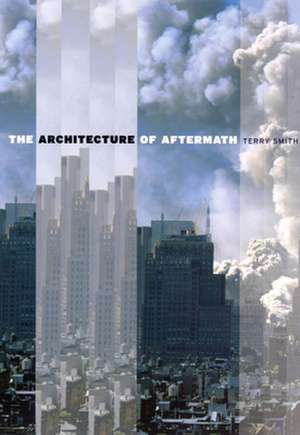The Architecture of Aftermath
Autor Terry Smithen Limba Engleză Hardback – 30 oct 2006
The September 11 terrorist attacks targeted, in Osama bin Laden’s words, “America’s icons of military and economic power.” In The Architecture of Aftermath, Terry Smith argues that it was no accident that these targets were buildings: architecture has long served as a symbol of proud, defiant power—and never more so than in the late twentieth century.
But after September 11, Smith asserts, late modern architecture suddenly seemed an indulgence. With close readings of key buildings—including Jørn Utzon’s Sydney Opera House, Minoru Yamasaki’s World Trade Center, Frank Gehry’s Guggenheim Museum Bilbao, and Richard Meier’s Getty Center—Smith traces the growth of the spectacular architecture of modernity and then charts its aftermath in the conditions of contemporaneity. Indeed, Smith focuses on the very culture of aftermath itself, exploring how global politics, clashing cultures, and symbolic warfare have changed the way we experience destination architecture.
Like other artists everywhere, architects are responding to the idea of aftermath by questioning the viability of their forms and the validity of their purposes. With his richly illustrated The Architecture of Aftermath, Smith has done so as well.
But after September 11, Smith asserts, late modern architecture suddenly seemed an indulgence. With close readings of key buildings—including Jørn Utzon’s Sydney Opera House, Minoru Yamasaki’s World Trade Center, Frank Gehry’s Guggenheim Museum Bilbao, and Richard Meier’s Getty Center—Smith traces the growth of the spectacular architecture of modernity and then charts its aftermath in the conditions of contemporaneity. Indeed, Smith focuses on the very culture of aftermath itself, exploring how global politics, clashing cultures, and symbolic warfare have changed the way we experience destination architecture.
Like other artists everywhere, architects are responding to the idea of aftermath by questioning the viability of their forms and the validity of their purposes. With his richly illustrated The Architecture of Aftermath, Smith has done so as well.
Preț: 515.36 lei
Preț vechi: 654.26 lei
-21% Nou
Puncte Express: 773
Preț estimativ în valută:
98.63€ • 107.09$ • 82.85£
98.63€ • 107.09$ • 82.85£
Carte indisponibilă temporar
Doresc să fiu notificat când acest titlu va fi disponibil:
Se trimite...
Preluare comenzi: 021 569.72.76
Specificații
ISBN-13: 9780226764689
ISBN-10: 0226764680
Pagini: 280
Ilustrații: 58 halftones
Dimensiuni: 178 x 254 x 20 mm
Greutate: 0.8 kg
Editura: University of Chicago Press
Colecția University of Chicago Press
ISBN-10: 0226764680
Pagini: 280
Ilustrații: 58 halftones
Dimensiuni: 178 x 254 x 20 mm
Greutate: 0.8 kg
Editura: University of Chicago Press
Colecția University of Chicago Press
Notă biografică
Terry Smith is the Andrew W. Mellon Professor of Contemporary Art History and Theory in the Department of the History of Art and Architecture at the University of Pittsburgh.
Cuprins
Acknowledgments
List of Illustrations
Introduction: After Effects—Architecture, Iconomy, Contemporaneity
Part I: Dispacing Time
1. The Bilbao Affect: Culture as Industry
2. Flashback: Uluru and the Sydney Opera House
3. The Past-Modern Present: Empire Redux at the Getty Center
4. Remembrance Now: Architecture after Auschwitz at the Jewish Museum, Berlin
Part II: Targets and Opportunities
5. WTC Fast Forward: Skyscrapers on the Isle of the Dead
6. Architecture’s Unconscious: Trauma and the Contemporary Sublime at Ground Zero
7. Shock.Build.Mourn.Hope: Architects Confront Contemporaneity
Conclusion: Aftermath and After
Notes
Index
List of Illustrations
Introduction: After Effects—Architecture, Iconomy, Contemporaneity
Part I: Dispacing Time
1. The Bilbao Affect: Culture as Industry
2. Flashback: Uluru and the Sydney Opera House
3. The Past-Modern Present: Empire Redux at the Getty Center
4. Remembrance Now: Architecture after Auschwitz at the Jewish Museum, Berlin
Part II: Targets and Opportunities
5. WTC Fast Forward: Skyscrapers on the Isle of the Dead
6. Architecture’s Unconscious: Trauma and the Contemporary Sublime at Ground Zero
7. Shock.Build.Mourn.Hope: Architects Confront Contemporaneity
Conclusion: Aftermath and After
Notes
Index
